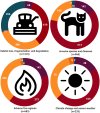A national-scale dataset for threats impacting Australia's imperiled flora and fauna
- PMID: 34522338
- PMCID: PMC8427562
- DOI: 10.1002/ece3.7920
A national-scale dataset for threats impacting Australia's imperiled flora and fauna
Abstract
Australia is in the midst of an extinction crisis, having already lost 10% of terrestrial mammal fauna since European settlement and with hundreds of other species at high risk of extinction. The decline of the nation's biota is a result of an array of threatening processes; however, a comprehensive taxon-specific understanding of threats and their relative impacts remains undocumented nationally. Using expert consultation, we compile the first complete, validated, and consistent taxon-specific threat and impact dataset for all nationally listed threatened taxa in Australia. We confined our analysis to 1,795 terrestrial and aquatic taxa listed as threatened (Vulnerable, Endangered, or Critically Endangered) under Australian Commonwealth law. We engaged taxonomic experts to generate taxon-specific threat and threat impact information to consistently apply the IUCN Threat Classification Scheme and Threat Impact Scoring System, as well as eight broad-level threats and 51 subcategory threats, for all 1,795 threatened terrestrial and aquatic threatened taxa. This compilation produced 4,877 unique taxon-threat-impact combinations with the most frequently listed threats being Habitat loss, fragmentation, and degradation (n = 1,210 taxa), and Invasive species and disease (n = 966 taxa). Yet when only high-impact threats or medium-impact threats are considered, Invasive species and disease become the most prevalent threats. This dataset provides critical information for conservation action planning, national legislation and policy, and prioritizing investments in threatened species management and recovery.
Keywords: Australian threatened species; EPBC Act; IUCN Threat Classification Scheme; IUCN Threat Impact Scoring System; Threat impacts; Threatened species.
© 2021 The Authors. Ecology and Evolution published by John Wiley & Sons Ltd.
Conflict of interest statement
The authors declare no competing interests.
Figures



References
-
- Allek, A., Assis, A. S., Eiras, N., Amaral, T. P., Williams, B., Butt, N., Renwick, A. R., Bennett, J. R., & Beyer, H. L. (2018). The threats endangering Australia’s at‐risk fauna. Biological Conservation, 222, 172–179.
-
- Barnosky, A. D., Matzke, N., Tomiya, S., Wogan, G. O. U., Swartz, B., Quental, T. B., Marshall, C., McGuire, J. L., Lindsey, E. L., Maguire, K. C., Mersey, B., & Ferrer, E. A. (2011). Has the Earth’s sixth mass extinction already arrived? Nature, 471, 51–57. - PubMed
-
- Birdlife International (2018). Anthochaera phrygia. 10.2305/IUCN.UK.2018-2.RLTS.T22704415A130992272.en - DOI
-
- Black, K., Archer, M., Hand, M., & Godthelp, H. (2012). Earth and life. In Talent J. (Ed.), International Year of Planet Earth (pp. 1–1100). Springer.
-
- Black‐throated Finch Recovery Team (2020). National recovery plan for the Black‐throated finch southern subspecies (Poephila cincta cincta). Black‐throated Finch Recovery Team.
Associated data
LinkOut - more resources
Full Text Sources

